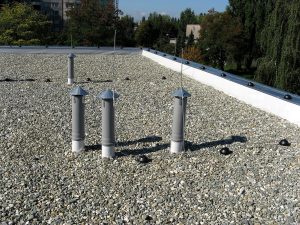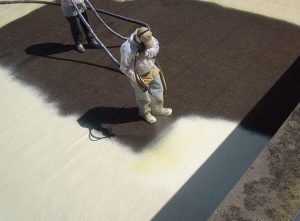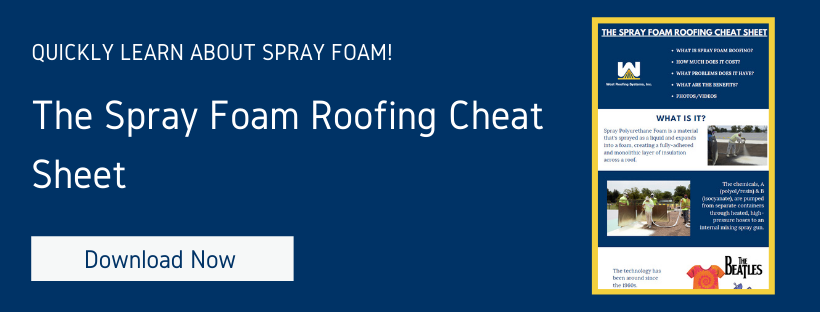When you think of a commercial roof, you may think of black tar being mopped on a flat roof. But nowadays you have more options to meet your pricing and performance needs.
What’s the difference between “traditional” built-up roofing and Spray Polyurethane Foam Roofing?
At West Roofing Systems, we want to make sure that our future clients have the best information available. For this reason, we created an article that explores the differences between built-up and spray foam roofing systems to give you all the information you need in choosing which roof is the best fit for your facility.
The Basics
Built-Up Roofing

Built-Up Roofing Systems have been in use in the U.S. for over 100 years. These roof systems are commonly referred to as “tar and gravel” roofs. Built-up systems are installed by alternating layers of asphalt or tar and supporting fabrics directly onto the roof. You can choose the number of layers (or plies) that are installed. The final layer of a built-up roofing system consists of stone or gravel.
Spray Polyurethane Foam (SPF) Roofing
Spray Polyurethane Foam, more commonly referred to as SPF, is a liquid that is sprayed on the existing roof and expands into a foam, creating a solid layer across an existing roof.
While SPF roofing is not the most known type of roofing material, the technology has been around since the early 1960s for industrial, commercial, and residential facilities.
Cost
Built-Up Roofing
For an average commercial roof, it will usually cost between per $5.50 – $8.50 square foot in materials and labor to install a typical built-up roofing system. This price range can change depending on the materials you choose.
Spray Foam Roofing
For an average 20,000 sq. foot commercial roof, it will usually cost between $4.00 and $7.00 per square foot in materials and labor to install a typical SPF roofing system. This price range is for an SPF roof of average thickness and building structure.
Through energy savings, a spray foam roof can pay for itself in 5-10 years.
Installation
Built-Up Roofing

The first layer can adhere directly to the roof substrate. If needed, a base sheet can be fastened to the roof to create a flat and safe workspace. A built-up roofing system is installed by alternating layers of bitumen and reinforced fabric. Property managers can choose three, four or five ply roofs to meet their needs and budgets.
The last layer is rock or stone, this layer protects the underlying layers from UV rays, extreme heat or cold, and wind damage. A layer of gravel can be added to be more aesthetically appealing.
Spray Foam Roofing
Before the installation can start, the existing roof needs to be prepared, which is usually accomplished through power washing with around 3500 PSI.
Rather than stripping the entire existing roof, the contractor will only remove the saturated areas through an infrared survey.
A roofing contractor will prepare the substrate by getting rid of all dirt, dust, and contaminants.
The first layer put down by the contractor is the polyurethane foam. This foam is created by combining two liquids as it’s sprayed onto the existing roof substrate. As the liquid is sprayed onto the existing roof, it expands to form a solid foam surface.
When the SPF layer has been completed, it is then coated with a layer(s) of elastomeric silicone or acrylic coating with embedded granules.
Advantages
Built-Up Roofing
If properly installed and maintained, a commercial built-up roof can last 40 years. There are a few other benefits of built-up roofing systems:
- Seamless and Waterproof – The continuous solid surface does not require joints or seams, removing the most vulnerable area for leaking.
- Reflects UV Rays – Provides ultra-violet protection.
- Low-maintenance – Minimal upkeep needed after installation.
Spray Foam Roofing
When properly installed and maintained, a commercial spray foam roof can last indefinitely. There are quite a few other benefits of SPF roofing systems:
- Energy Efficient – SPF delivers thermal, air, and moisture barriers to provide the highest R-value at 6.6 per square inch.
- Durable – The foam material can expand and contract with the building, decreasing the likelihood of cracks and splitting. SPF has a compression strength of 50 PSI per square inch and is easily strong enough to walk on.
- Seamless and Waterproof – The continuous solid surface does not require joints or seams, removing the most vulnerable area for leaking.
- Environmentally Friendly – In most cases, there is minimal stripping of the original roof – eliminating the need for costly roof tear-offs and waste. The materials that are used for SPF roofing systems are also environmentally friendly: Zero Ozone Depleting Potential (ODP), Low in the Emission of Volatile Organic Compounds (VOCS), Free from Chlorofluorocarbons (CFCS), Ultra-Low Global Warming Potential (GWP).
- Easily Repairable – Finding areas that need repair are very simple. Just look for cracks in the coating. Once identified, all you need to do is clean and dry the area, fill the crack with coating, and smooth out.
- Installed Quickly – On an installation, only the saturated areas need removed and replaced (not the entire roof), which saves on labor and material costs.
- Water Cannot Travel Laterally– if a crack happens, the water sits inside that crack. Water cannot continue it’s travel due to foam being closed-cell.
Read More: Pros and Cons of Spray Polyurethane Foam (SPF) Roofing Systems
Disadvantages
Built-Up Roofing
Built-up roofing systems have been around for decades; their longevity can only be obtained if the roof is maintained properly. Here are other disadvantages of built-up roofing systems:
- Time – Slower installation timeframe
- Safety – Hazardous fumes and vapors when installing it
- Weight – Adds extra weight to the building structure
- Costs – Higher installation costs than a spray foam roof
- UV Rays – Without the gravel top layer, UV rays can break down the membrane quickly
- Hard to Identify Leaks – It’s very, very difficult to identify where the leak is coming from with a roof full of stones and rock
- Allows Water to Travel Laterally – when water enters the insulation, it can travel laterally and create multiple leaks throughout the building
Spray Foam Roofing
While the advantages of an SPF roofing system outweigh the disadvantages, there are a few things you should keep in mind. Here are the disadvantages of SPF roofing systems:
- Hire the Right Professional – The contractor needs to be precise with the application and have a solid understanding of the chemicals they are using.
- Limited Installation Window – Installation of an SPF roofing system cannot be performed during cold, windy, or rainy weather.
- Overspray Potential – Since the SPF is installed by a spray application, there is a risk of the wind carrying overspray onto surrounding cars and other surfaces.
- Maintenance – SPF roofing systems need to be inspected once per year at least.
West Roofing Systems, Inc. installs sustainable and efficient roofing systems for commercial, industrial, manufacturing, and municipal buildings. In over 40 years, we have installed over 60,000,000 square feet of commercial Spray polyurethane foam (SPF), single-ply membrane, and other popular roofing systems.
If you are looking for maintenance, repair, or replacement for your facility’s roof, fill out our quote form for your free, no-obligation commercial roof quote from our team of experts.


